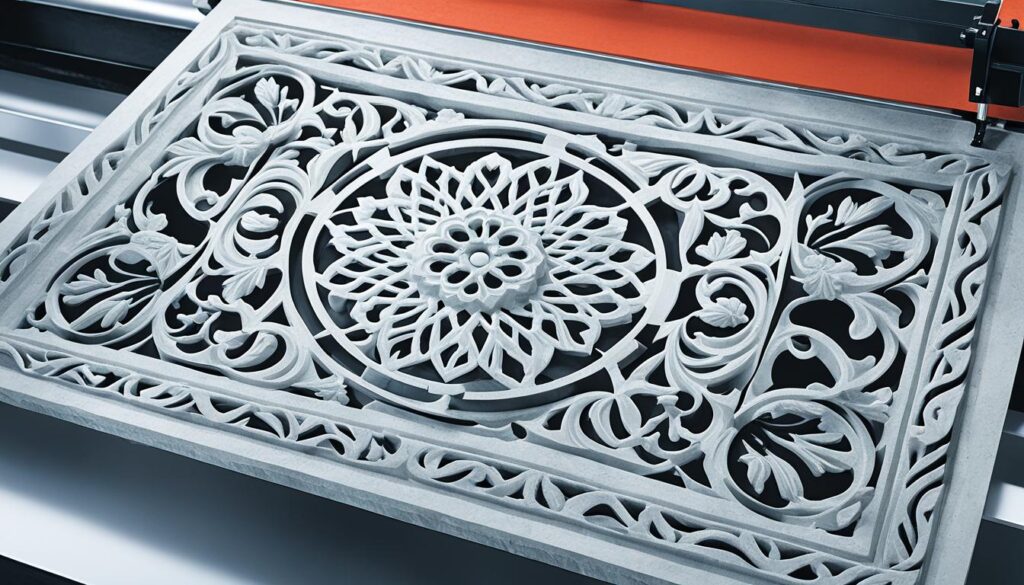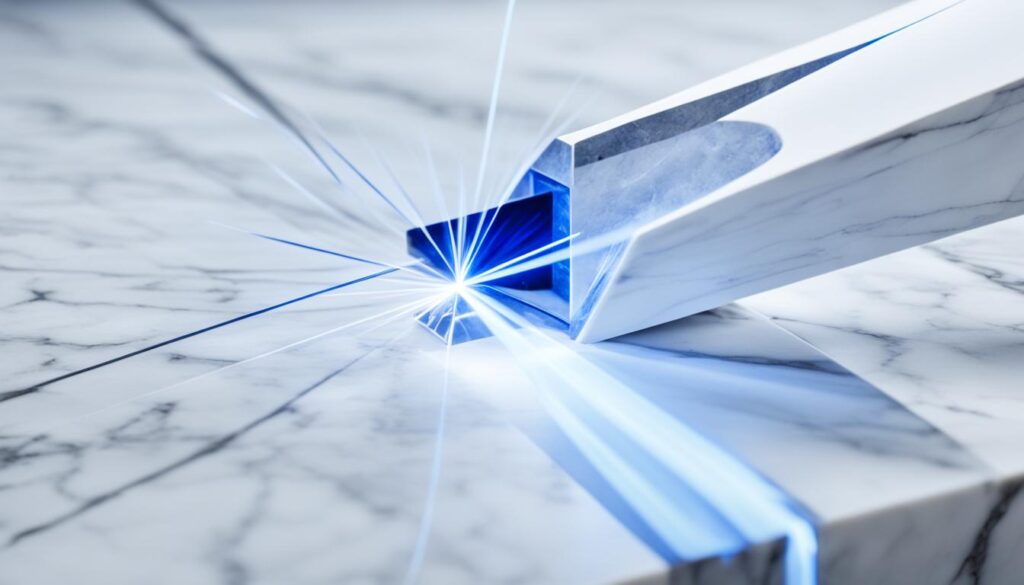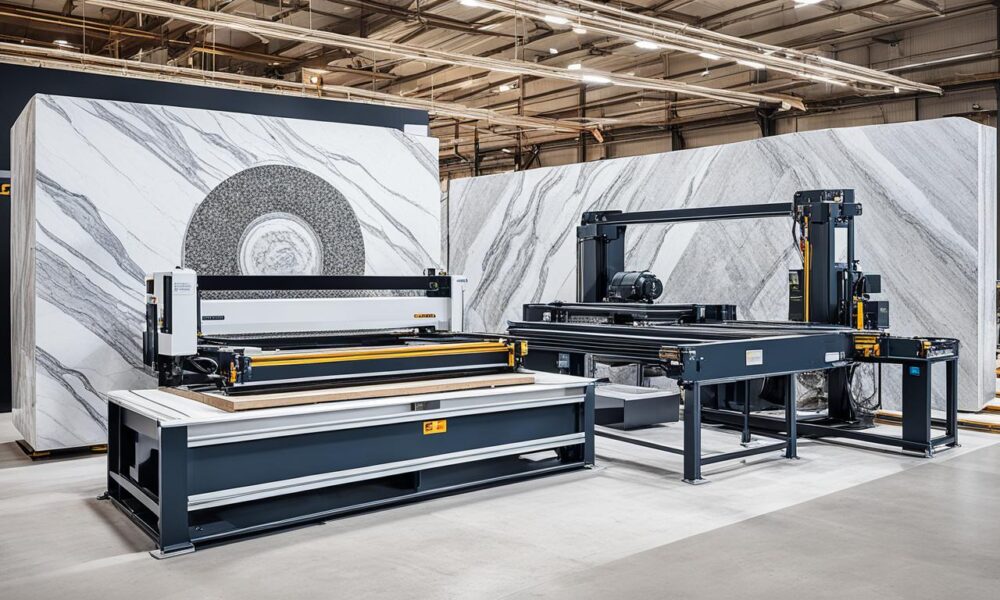Revolutionizing Marble: Technology in Stone Industry
The stone industry is seeing big changes thanks to new marble-cutting technology. With waterjet cutting and laser cutting systems, we’re cutting with 30% more precision than old-school ways1. Plus, laser tech slashes marble cutting time by 25%, ramping up how much we can produce1.
Robots and automation are changing the game too. They’ve cut labor costs by 20% for stone companies1 and halved the number of accidents at work1. Also, these cool techs mean we’re wasting 40% less material, which is great for our planet1.
With all these tech upgrades, architects and designers are asking for 15% more custom designs1. This wave of tech is pushing the natural stone field into a bright, eco-friendly future. It’s a big leap forward in how we use digital tools.
Key Takeaways
- The stone industry has achieved a 30% increase in cutting precision with waterjet technology1.
- Laser cutting systems reduced marble slab cutting time by 25%1.
- Automation and robotics decreased labor costs by 20% and workplace accidents by 50%1.
- Advanced cutting technologies have resulted in a 40% reduction in material waste1.
- There is a 15% rise in custom design requests from architects and designers1.
Innovative Marble-Cutting Technologies
The marble industry has greatly improved with new tech changes. These changes have completely reshaped how stones are made. They make sure stones are cut precisely and help in keeping stone making green.
Waterjet Cutting
Waterjet cutting uses high-pressure water and sand to cut marble cleanly. It’s great for making complex designs and is eco-friendly by reducing waste. This method is chosen for its fine detail in marble creations.
Laser Cutting Systems
Laser cutting is famous for its quick and spot-on cutting, making perfect joins in quality stone works. With lasers, the cuts are very accurate, waste is less, and all pieces are the same2.
Automation and Robotics
Automation and robots have changed the marble game by doing repetitive tasks fast and well. They let us make complex patterns easier than before2. Robots mean consistent quality, lower costs, and more output. Advanced tech also makes workplaces safer for people2.
Together, these cutting-edge tools have raised the bar in stone making. They guarantee detailed stone cuts and encourage environment-friendly methods. This is a big leap in the progress of stone making.
How Technology is Transforming the Natural Stone Industry
The natural stone industry has changed a lot since it started. Now, with digital technology, we see big improvements. These include better designs and greener practices. Let’s explore how history, technology, and design have blended together.
Historical Overview of Stone Fabrication
Long ago, making stone products was all done by hand. It took a lot of work and skill. Carving stone by hand made amazing buildings but wasted a lot of material. In the 19th century, machines started to change everything. They made work faster and more accurate.
Emergence of Digital Technologies
Now, digital tech has totally changed the stone industry. CNC machines and robots do the hard work. They make detailed stone pieces with less waste345.
Tools like 3D modeling and virtual reality show us what the final piece will look like early on. This helps make better designs and saves resources3. Augmented reality helps clients and designers see the same vision4.
Cloud tools let architects, designers, and makers talk to each other in real time. This makes designing and making things smoother4.
Integration in Interior Design
These tech advances also led to new design ideas. Companies are mixing traditional skills with new tech for unique interiors. Features like LED lights and wireless charging are getting popular4.
New finishing methods are making stone surfaces even more special. Cutting-edge tech also lets makers copy natural patterns accurately, making things look great4.
The move to digital has made the industry more green. It focuses on using less and sourcing responsibly. For example, some companies use tech to cut down on waste and power use34.
Advancements in Stone Fabrication Techniques
Technology has deeply changed the stone industry, thanks to new tools like CNC machines and waterjet cutters. These tools have made tasks that seemed impossible possible.
CNC machines make shaping stone much easier by using automation and precise control. They work well with complex designs and digital models. With the help of CAD software6, creating detailed patterns, textures, and shapes in quartz has become highly accurate. This marks a significant leap in stone fabrication, benefiting both makers and buyers.
Waterjet technology is amazing because it cuts stone without heat, keeping the stone’s quality high. It uses advanced materials that make quartz surfaces tough against scratches, stains, and impacts6. Waterjet cutting makes the stone products look better and last longer.

Cutting and polishing techniques for quartz have seen major improvements. Now, manufacturers can offer a wide range of colors, from soft to bright, using special methods6. This lets people get more creative and personal with their quartz choices.
New advancements in bridge saw technology also show how tech has changed the stone industry. Zonato’s FPZ 700 bridge saw is known for its durability, precise cuts, and low operating costs7. Pedrini Co.’s M 912 CN bridge saw uses advanced controls to increase cutting accuracy and efficiency7. These developments make stone work faster and allow for newer designs, showing the importance of technology in stone fabrication.
Laser Technology in Stone Fabrication
Laser technology has reshaped stone fabrication. It brings unmatched precision and efficiency. Now, intricate designs are made quickly and accurately thanks to laser cutting. Tools like CAD/CAM software let designers create detailed patterns and shapes8. This speeds up production, boosting both artistic value and efficiency.
Laser scanning technology has modernized stone polishing. It guides robotic systems to polish stone surfaces consistently8. This improves the final product’s quality and cuts down on manual work. Diamond wire sawing slices stone blocks fast and accurately, producing thin slabs and detailed shapes8. This shows the growing reliance on laser technology.
Laser engraving adds significant artistry to stone fabrication. It etches images and text onto stone, increasing artistic appeal. This technique complements laser cutting’s precision, allowing for both decorative and practical uses.
Advanced systems like the M 940 CN bridge saw from Pedrini make cutting even more precise9. It’s controlled by an industrial PC for exact cuts. AI helps optimize these cuts, reducing waste and boosting efficiency8. These innovations lead to a more integrated approach in stone fabrication.

Tools like Marmo Meccanica USA’s HTO-1/O and Pyramid Supply’s Cemar SG725 bridge saw make laser tools better and more durable9. They help innovate craftsmanship and push the stone industry towards eco-friendly practices.
Here is a comparative overview of some notable laser-enhanced stone fabrication tools:
| Machine Model | Laser Technology | Key Features |
|---|---|---|
| M 940 CN (Pedrini) | Laser-guided PC control | Six movement precision9 |
| HTO-1/O (Marmo Meccanica USA) | Direct-drive motor | 12.5-hp power9 |
| Cemar SG725 (Pyramid Supply) | Variable spindle speed | Cast iron structure9 |
3D Printing and Stone Construction
3D printing is changing stone construction by mixing old materials with new methods. It allows for precise creation of detailed designs that were hard to make before. This innovation is reshaping how we build with stone.
Combining Ancient Material with Modern Technology
In 2021, 3D printing for stone construction was valued at $190 million. By 2030, it’s expected to reach $680 million10. This shows how important 3D printing has become. It’s growing fast, with a 91.5% annual increase by 202810.
This tech cuts construction time by 70%, finishing projects faster10. It also creates 60% less waste10. Plus, it can lower labor costs by 80%10, making it cheaper and greener.
Case Studies
Case studies show 3D printing’s big impact. It makes light stone panels for new building looks. Also, artists can now create complex sculptures that were once impossible.
Companies see big benefits like quicker builds and less waste. 3D printing also brings unmatched durability and detail. It’s a game-changer in stone construction.
To learn more, read a detailed analysis here. It dives into how 3D printing blends tradition with technology.
Conclusion
The stone industry skillfully mixes old traditions with new technologies today. Tools like waterjet cutting and laser systems have changed how we work with stone. These advancements, alongside 3D printing, have opened up new creative paths11. Sustainability is also key. Efforts to replant trees and manage water better are becoming common in quarries11. This sustainable approach makes natural stone a top choice for its strength and ability to be recycled11.p>
Looking ahead, the future of the stone industry is very promising. By 203212, experts foresee it growing steadily to reach high financial milestones. This growth will come from its use in building, decorating, making furniture, and more12. Even with the hurdles from global events like the conflict in Ukraine and the aftermath of COVID-19, the stone industry is finding ways to succeed12.
In this evolving field, old meets new in exciting ways. Digital imaging now lets us create stone pieces with incredible precision. There are also innovative finishes like honed, polished, leather, and brushed surfaces11. Thanks to these advances, the stone industry keeps its rich history alive while exploring new horizons. It’s a space full of promise for both craftsmen and customers11.
FAQ
How have technological advancements impacted the natural stone industry?
What are the benefits of waterjet cutting in stone fabrication?
How do laser cutting systems transform stone manufacturing?
What role do automation and robotics play in the stone industry?
How has the integration of digital technologies transformed interior design using natural stone?
What advancements have been made in stone fabrication techniques?
Why is laser technology significant in stone fabrication?
How is 3D printing changing stone construction?
Source Links
- Innovative Marble Cutting Technology Revolutionizes Stone Manufacturing – News
- Revolutionizing Fitouts: The Technological Marvels of Marble and Stone Work
- The Impact of Technology on the Natural Stone Industry
- Trends Shaping the Future of Stone Fabrication in 2024 – Prodim
- Take Advantage of the Latest Technology When Designing with Natural Stone – Use Natural Stone
- Innovation in Stone: The Latest Technological Advancements in Quartz Manufacturing
- Advancements in Fabricating Technology
- Harnessing Technology in Stone Fabrication: A Look at Cutting-Edge Techniques – Ms Africa
- Fabricating Technology roundup
- 3D Printing In Construction: How Does It Work | Cemex Ventures
- “The Future of Natural Stone: New Trends and Technologies” – Earth Stone – Marble & Granite
- Natural Stone Market Size Expected to Increase Due to High Demand Forecast 2024-2032



